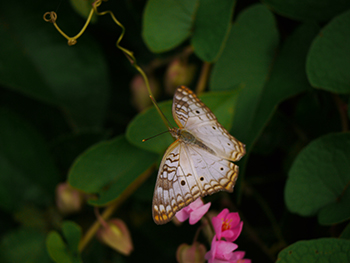This post is also available in: Dutch (below)
Most butterflies on the islands can be seen during the rainy season. This is of course not surprising because these delicate insects are bound to plants with flowers from which they can suck their nectar, which must provide the much-needed energy to be able to reproduce. In addition, butterflies often have specific plants that they need to lay their eggs on, since the caterpillars, once they hatch from the egg, need a lot of leaves to eat and grow, and then pupate into an adult butterfly. Certain butterflies have multiple types of hostplants, and other species are very specifically bound to one particular plant.
Hostplant: Lippia (Phyla nodiflora)

And yet butterflies can also be found on our islands during the dry season, if you know where to look. A good example is the White Peacock butterfly, which can still be found in dried-up dams or tankis and sometimes even along the verges of busy roads during the drier, hot month of July. The only thing this species needs is the plant called Lippia or Kamele blum shimaron (Phyla nodiflora). This is the plant on which these butterflies lay their eggs and where the caterpillars can eat their fill before they pupate. The butterflies lay an egg under a leaf of the host plant, where it can develop into a caterpillar that will almost completely eat the host plant bare and that is often very visible in the field in the dams. The eggs are green in colour and are small, while the caterpillars are black with white dots and spines.
Territorial
A striking feature of this butterfly can be seen immediately when the animal opens its wings. There are three dark spots on the wings that are positioned symmetrically; one on the forewings and two on the hindwings. Along the edges of the wings is a light brown, almost orange tint.
The funny thing about these butterflies is that the males are very territorial, a behaviour that one does not immediately associate with butterflies. The territory covers about 15 square meters and this piece or real estate is aggressively defended against the entrance of other males of the same species and even against other insects. Only the females are allowed in.
This butterfly is found from the southern United States, Central America and parts of the Caribbean, including Aruba, Bonaire and Curacao, as well as St. Domingo and Puerto Rico.
English name: White Peacock
Papiamentu name: Barbulètè pòwis blanku
Scientific name: Anartia jatrophae
Family: Nymphalidae (brush-footed butterflies)
Occurrence (ABC islands): Aruba, Bonaire and Curaçao

Vlindersoort: White peacock
De meeste vlinders op de eilanden zijn te zien in de regenperiode. Dat is natuurlijk niet gek omdat deze tere insecten gebonden zijn aan planten met bloemen waaruit ze hun nectar kunnen zuigen dat voor de broodnodige energie moet zorgen om zich te kunnen voortplanten. Daarbij hebben vlinders vaak specifieke planten die ze nodig hebben om hun eieren op te leggen aangezien de rupsen, als ze eenmaal uit het ei komen, flink veel blaadjes nodig hebben om op te eten en daarmee te groeien, en vervolgens te verpoppen tot een volwassen vlinder. Bepaalde vlinders hebben meerdere soorten planten als gastheer, en andere soorten zijn weer heel specifiek aan één bepaalde plant gebonden.
Waardplant: Phyla nodiflora

En toch zijn er ook in de droge periode op onze eilanden vlinders te vinden, als je weet waar je moet kijken. Een goed voorbeeld is de White Peacock vlinder die in de drogere hete maand juli nog steeds te vinden is in drooggevallen dammen en tanki’s en soms zelfs langs bermen bij drukke wegen. Het enige dat deze soort nodig heeft is het plantje met de naam Kamele blum shimaron (Phyla nodiflora). Dit is namelijk de plant waarop deze vlinders hun eieren leggen en waar de rupsen zich kunnen volvreten voor ze gaan verpoppen. De vlinders leggen een ei onder een blad van de gastheerplant, waar het zich kan ontwikkelen tot een rups die de gastheerplant bijna helemaal kaal zal eten en dat is in het veld in de dammen vaak heel goed te zien. De eieren zijn groen van kleur en zijn klein, terwijl de rupsen zwart van kleur zijn met witte stippen en stekels.
Territoriaal
Een opvallend kenmerk van deze vlinder is direct te zien als het dier zijn vleugels opent. Er zitten namelijk drie donkere vlekken op de vleugels die symmetrisch zijn gepositioneerd; één op de voorvleugels en twee op de achtervleugels. Langs de randen van de vleugels zit een lichtbruine, bijna oranje tint.
Het grappige met deze vlinders is dat de mannetjes zeer territoriaal zijn, een gedrag dat men niet direct met vlinders associeert. Het territorium beslaat ongeveer 15 vierkante meten en dit stukje wordt op agressieve wijze verdedigt tegen de entree van andere mannen van dezelfde soort en zelfs tegen andere insecten. Alleen de vrouwtjes mogen naar binnen.
Deze vlinder komt voor vanaf zuidelijk Verenigde Staten, Midden-Amerika en delen van het Caribisch gebied, waaronder Aruba, Bonaire en Curaçao, evenals St. Domingo en Puerto Rico.
Nederlandse naam: –
Papiamentse naam: Barbulètè pòwis blanku
Wetenschappelijke naam: Anartia jatrophae
Familie: Nymphalidae (vossen, parelmoervlinders en weerschijnvlinders)
Voorkomen (ABC eilanden): Aruba, Bonaire en Curaçao